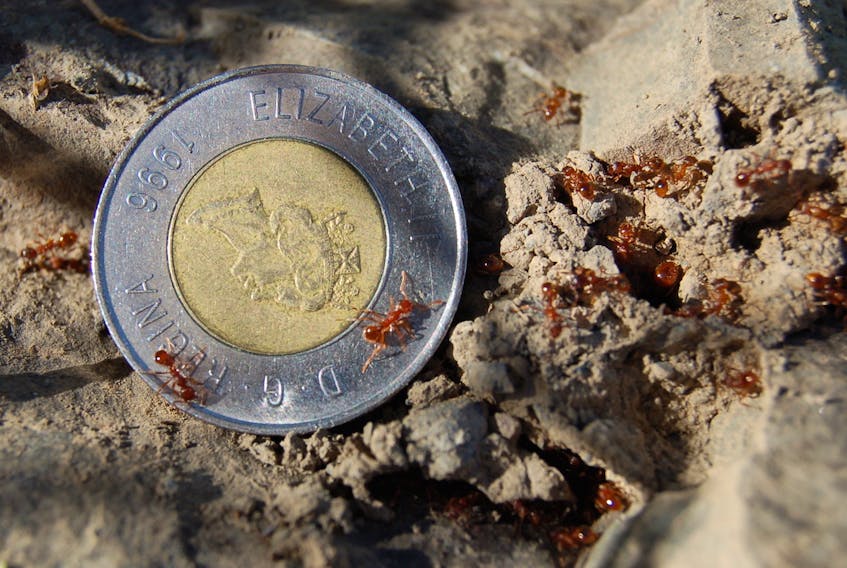
CARBONEAR, NL — If you're out in your garden on a warm sunny day (not an immediate prospect undoubtedly) and suddenly feel a sting in your foot, chances are your lawn is the home of an invasive insect originating from Europe.
"They're very aggressive ants, so they don't like anybody near their nests," said Barry Hicks, a scientist at College of the North Atlantic's Carbonear campus who has been studying European fire ants (Myrmica rubra) for years.
"The sting is like a wasp's sting. So, when a lot of people talk about ants, they talk about ant bites. That's not the issue here. An ant bite is not that serious, but in this case, they sting like a wasp and they inject a venom. So, when they sting, it hurts."
As an invasive species, fire ants are known to exclude other insects and out-compete native ants and other soil-dwelling invertebrates. They also farm aphids, which suck sap from trees and supply the ants with honeydew. Aphids help produce disease in plants, making the presence of these ants on lawns less than ideal.
Hicks’ first confirmed sighting of the ant in Carbonear occurred during a survey in 2011. At that point, its presence was restricted to the north side of town. A further survey completed last summer backed up those findings.

"I think initially I had discovered it in the fall of 2010, but then the summer of 2011 I did some sampling all over the area just to get a sense of where the infestation was," explained Hicks, a biology instructor at the college who has a PhD in forest entomology from the University of Edinburgh in Scotland.
Documented sightings through Hicks' surveys start at Musgrave Street and continue east as far as Sutton's Hill. The northern boundary for the ant is located around Moores Hill and Burden's Hill.
The ants have also been found in Brigus near the churches and cemeteries on Middle Ridge and at Shea's Lane.
The survey this summer was completed with a student. Hicks said literature from surveys taken elsewhere had suggested it would have been unlikely for the ants' habitats to spread.
The ant has been documented in Corner Brook and areas in St. John's. Some reports from the public suggest the fire ant can also be found in Central Newfoundland, though no specimens have been collected from surveyed areas.
Ants' origins

Beyond periodic surveys, Hicks is also part of a project looking into the DNA of Newfoundland's fire ants in comparison to those found in England and mainland North America.
It has previously been thought the ants came to the island of Newfoundland by moving contaminated soil from the mainland to local garden centres. However, Hicks' own research, in collaboration with profs from Memorial University, suggests that based on DNA analysis, Newfoundland ants found on the Avalon Peninsula have more in common English fire ants.
"That means they came directly from Britain, so then the question is, well, how did that happen?
“If you look back in the literature with regards to insects and plants, the Avalon Peninsula has been the place where many plants and animals have been introduced from Britain,” he said. “And it goes way back, because 300 years ago, ships would leave the southwest part of England empty, and they would come to Newfoundland to get salt fish.
“When the ships are leaving and they're empty, they need to weigh the ships down with something, so they used soil from around the communities of Britain that they're leaving from."
According to Hicks, these boats initially dumped the soil into the water, but that practice changed with time, as there were concerns the continued accumulation of soil would negatively impact harbours.
"That introduced a whole bunch of plants, a whole bunch of insects, and in fact Newfoundland has more introduced species than anywhere else in North America from Britain," he said.
"When I did the DNA analysis on it, what's interesting is the ants are located in Poole, which would have been the main area where ships were leaving (England) to come to Carbonear."
It's hard to pinpoint exactly when the European fire ant was introduced to the area, but Hicks said it would have been before the days of steam ships at the turn of the 20th century.
"I'm suggesting the ants have been here 100 or 150 years at least," he said. "Anecdotally, speaking to some old people that know these ants because they've been stung, I had one old guy … he remembers them 50 years ago when he was a kid."
Hicks believes the European fire ant was introduced to St. John's in a similar fashion.
Not found in oldest towns

While he has found evidence fire ants in Brigus, Hicks has not located any in Cupids. He finds this odd given the history of that community exceeds 400 years, and feels similarly about Ferryland.
"That's an old community, and there's literature suggesting that plants were brought to those areas, so I anticipate ants maybe showing up down there. But I've searched and haven't been able to find anything."
A new area of interest for Hicks with respect to the Newfoundland variant of European fire ants is their breeding habits. In 2011, he identified an all-male nuptial flight with 57 males. Swarming among European fire ants is generally unheard of in North America, though it is a known trait of the insect in Europe.
"I saw these swarms and I started to ask questions like, well, why are they swarming? Are they using that as a mechanism to disperse? Because of course, you'd want males and females from different colonies to get together to create the variation that you need in populations.
“I started to do this project looking at the genetic relatedness of all the populations in Newfoundland to see how closely related (they are) or how often they're having sex.”
He has yet to publish any findings on this topic, but in Carbonear, Hicks has found the fire ants are all genetically related and not breeding with those in places like Brigus or St. John's.
Placing ants from different colonies in a self-contained arena of sorts, he's also observed Carbonear ants avoiding harmful contact with their brethren. But if there's a St. John's ant in the picture, they'll start stinging each other.
"The aggression test that I did basically mirrored what I saw in the molecular data,” said Hicks. “The ones that aren't related are fighting all the time, whereas the ones that are related aren’t fighting."
On the west coast, there are two identified locations for the fire ants in Corner Brook, but oddly enough, they're not genetically related.
"They're not having sex with each other, and they came from two different origins."









